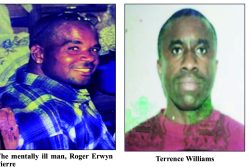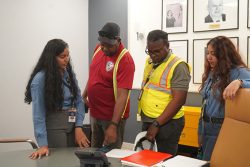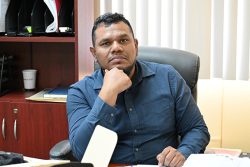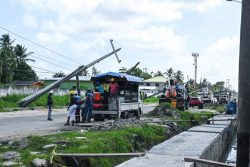Canadian mining company, Reunion Manganese forecasts an investment of US$250 million at its Matthew’s Ridge project with commissioning of the manganese mine slated for mid-2014 despite challenges with poor infrastructure, shortage of skills and red tape.
Reunion plans to extract two million tonnes of manganese concentrate per year and is optimistic about the future in the light of increasing world demand for the mineral, the company’s Chief Operating Officer, Joachim Bayah told a Guyana Manufacturing and Services Association (GMSA) luncheon today. The level of production that the company plans will “put Guyana on the world map,” Bayah said.
The Canadian company – a subsidiary of Reunion Gold Corporation – is focused on its Matthew’s Ridge manganese project in the North-West District. The company has four exploration permits (EPs) totalling 45,729 acres of manganese prospects around Matthew’s Ridge which are surrounded by two large prospecting permits (PPs) totalling approximately 40,000 square miles. The PLs are centred in and around the abandoned manganese mine at Matthew’s Ridge and Pipiani which was operated by a subsidiary of Union Carbide Corporation from 1962 to 1968. In excess of 1.66 million tonnes of manganese concentrate were shipped from the mine site during that period. Reunion was awarded the rights to Matthew’s Ridge in September 2010 and in March last year the company signed a mineral agreement with the Government of Guyana.
Bayah today outlined the company’s future plans and said that Reunion is targeting an initial resource of 20 million tonnes of +40% manganese concentrate. The company is fully financed to complete its 2011/2012 programmes, he said adding that there will be an aggressive exploration programme to deliver the resource and feasibility. The official said Reunion believes that the prospect has significant potential and noted the “low barriers to development” singling out the existing mine site, the low infrastructure requirements and the “manageable environment”.
He told the gathering which included Canadian High Commissioner, David Devine, that worldwide consumption is forecast to grow and by 2015 existing production will be short by 2 million tonnes of concentrate which is expected to come from new production including Guyana.
In terms of the project site, he said Matthew’s Ridge has benefits from infrastructure associated with the previous operation including the road, rail, and barge canal. He recalled that the previous operation exported concentrate by rail from the mine site to Port Kaituma, and then by barge to Trinidad and an infrastructure study is currently assessing options for development. In this regard, he said that the company is examining the feasibility of constructing a floating transshipment facility about 30 kilometres offshore for shipping the mineral further afield or barging the mineral to Trinidad to an Alcoa facility that is currently unused, for outward shipment. “We’re gonna weigh all these possibilities and see what makes sense,” he said.
Bayah said that the company plans to have the resources established by mid-year while a feasibility study should be completed by the end of this year, followed by construction by mid-next year. Operations are forecast to be commissioned by early-mid 2014, the official said.
In outlining expenditure, Bayah said that for 2011, this totalled US$21 million and he pointed out that the company also plans the construction of a US$1.2 million analytical laboratory to service Reunion and others. Employment was 300 persons last year with a similar amount expected to be hired this year. Construction will see over 1,000 workers being hired and about 500 will be employed during operation, Bayah said.
Geologists
In terms of infrastructure, the company official said the North-West will see improved roads as well as the rail link and there will be dredging and expansion of facilities for barging. He said that there will be openings for other development as well such as agriculture, aquaculture, mining and quarrying, forestry and reforestation and fabrication and other industrial development.
However, Bayah lamented several challenges faced by the company. One is the lack of skills, he said, singling out the dearth of geologists. He said they have 12 on site and only two are Guyanese. He said they had advertised for geologists in the local press but the response was “zero.” There are not enough geologists to support all the programmes in Guyana and they have embarked on sponsoring persons studying Geology at the University of Guyana, Bayah said.
He also lamented the bureaucratic procedures – saying these can sometimes “drive you crazy literally” – that have been experienced by the company in trying to clear goods. Bayah also cited an example of the company trying to bring a geologist from Ghana and waiting four months for the papers to be sorted out. “Some of these things deter serious investment,” he said adding that it frustrates people.
He said there are also challenges of infrastructure. He cited the road and also mentioned the airstrip. He said the landing strip because of increased flights has developed lots of potholes and when it rains, it is dangerous. “We are helping with the repair of the airstrip, we’re helping with the work of the road,” he said but added, “stakeholders can help but stakeholders are not in the infrastructure business.”









